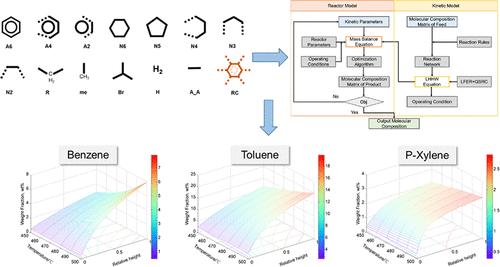当前位置:
X-MOL 学术
›
Ind. Eng. Chem. Res.
›
论文详情
Our official English website, www.x-mol.net, welcomes your feedback! (Note: you will need to create a separate account there.)
Molecular-Level Catalytic Reforming Kinetic Model Based on Modified Structure-Oriented Lumping
Industrial & Engineering Chemistry Research ( IF 4.2 ) Pub Date : 2024-04-12 , DOI: 10.1021/acs.iecr.3c04531 Zilong Jiang 1 , Guangqing Cai 2 , Ye Ji 2 , Lei Yang 2 , Wei Chen 2 , Xinping Wang 2 , Qunsheng Li 1
Industrial & Engineering Chemistry Research ( IF 4.2 ) Pub Date : 2024-04-12 , DOI: 10.1021/acs.iecr.3c04531 Zilong Jiang 1 , Guangqing Cai 2 , Ye Ji 2 , Lei Yang 2 , Wei Chen 2 , Xinping Wang 2 , Qunsheng Li 1
Affiliation

|
A kinetic model for the catalytic reforming process was developed at the molecular level. The structure-oriented lumping (SOL) method was modified to fit catalytic reforming, and a structural increment was created to distinguish between the xylene isomers; the xylene isomers are important reforming products. To model the governing chemistry, a reaction network involving 140 molecules and 697 reactions was generated in terms of 16 reaction rules. Then, a mathematical model of the naphtha reforming process was developed and included a reaction kinetic model and a reformer reactor model. The linear free energy relation (LFER) method was used to reduce the kinetic parameters. Experiments under different conditions were conducted to optimize the parameters. The results showed that the calculated values of the product yield and molecular composition were in good agreement with the experimental data. The conversion of hydrocarbon molecules was revealed by calculating the distribution of the molecules in the reactor. Sensitivity analysis was performed to investigate the effect of the reaction temperature on the molecular transformations.
中文翻译:

基于改进结构导向集总的分子级催化重整动力学模型
在分子水平上开发了催化重整过程的动力学模型。改进结构导向集总(SOL)方法以适应催化重整,并创建结构增量以区分二甲苯异构体;二甲苯异构体是重要的重整产品。为了对控制化学进行建模,根据 16 条反应规则生成了涉及 140 个分子和 697 个反应的反应网络。然后,开发了石脑油重整过程的数学模型,包括反应动力学模型和重整反应器模型。使用线性自由能关系(LFER)方法来降低动力学参数。通过不同条件下的实验来优化参数。结果表明,产物收率和分子组成的计算值与实验数据吻合较好。通过计算反应器中分子的分布来揭示烃分子的转化。进行敏感性分析以研究反应温度对分子转化的影响。
更新日期:2024-04-12
中文翻译:

基于改进结构导向集总的分子级催化重整动力学模型
在分子水平上开发了催化重整过程的动力学模型。改进结构导向集总(SOL)方法以适应催化重整,并创建结构增量以区分二甲苯异构体;二甲苯异构体是重要的重整产品。为了对控制化学进行建模,根据 16 条反应规则生成了涉及 140 个分子和 697 个反应的反应网络。然后,开发了石脑油重整过程的数学模型,包括反应动力学模型和重整反应器模型。使用线性自由能关系(LFER)方法来降低动力学参数。通过不同条件下的实验来优化参数。结果表明,产物收率和分子组成的计算值与实验数据吻合较好。通过计算反应器中分子的分布来揭示烃分子的转化。进行敏感性分析以研究反应温度对分子转化的影响。



























 京公网安备 11010802027423号
京公网安备 11010802027423号